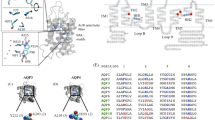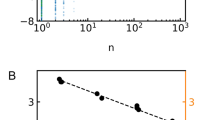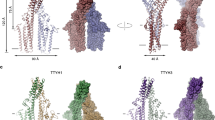Abstract
Aquaporins (AQP) are members of the major intrinsic protein (MIP) superfamily of integral membrane proteins and facilitate water transport in various eukaryotes and prokaryotes1,2. The archetypal aquaporin AQP1 is a partly glycosylated water-selective channel3,4 that is widely expressed in the plasma membranes of several water-permeable epithelial and endothelial cells2,5. Here we report the three-dimensional structure of deglycosylated, human erythrocyte AQP1, determined at 7Å resolution in the membrane plane by electron crystallography of frozen-hydrated two-dimensional crystals6,7. The structure has an in-plane, intramolecular 2-fold axis of symmetry located in the hydrophobic core of the bilayer. The AQP1 monomer is composed of six membrane-spanning, tilted α-helices. These helices form a barrel that encloses a vestibular region leading to the water-selective channel, which is outlined by densities attributed to the functionally important NPA boxes8 and their bridges to the surrounding helices. The intramolecular symmetry within the AQP1 molecule represents a new motif for the topology and design of membrane protein channels, and is a simple and elegant solution to the problem of bidirectional transport across the bilayer.
This is a preview of subscription content, access via your institution
Access options
Subscribe to this journal
Receive 51 print issues and online access
$199.00 per year
only $3.90 per issue
Buy this article
- Purchase on Springer Link
- Instant access to full article PDF
Prices may be subject to local taxes which are calculated during checkout




Similar content being viewed by others
References
Verkman, A. S. Water Channels (Landes, Austin, TX, (1993)).
Agre, P., Brown, D. & Nielsen, S. Aquaporin water channels: unanswered questions and unresolved controversies. Curr. Opin. Cell Biol. 7, 472–482 (1995).
Zeidel, M. L., Ambudkar, S. V., Smith, B. L. & Agre, P. Reconstitution of functional water channels in liposomes containing purified red cell CHIP28 protein. Biochemistry 31, 7436–7440 (1992).
van Hoek, A. N. & Verkman, A. S. Functional reconstitution of the isolated erythrocyte water channel CHIP28. J. Biol. Chem. 267, 18267–18269 (1992).
Verkman, A. S. et al. Water transport across mammalian cell membranes. Am. J. Physiol. 270, C12–C30 (1996).
Mitra, A. K., Yeager, M., van Hoek, A. N., Wiener, M. C. & Verkman, A. S. Projection structure of the CHIP28 water channel in lipid bilayer membranes at 12-Å resolution. Biochemistry 33, 12735–12740 (1994).
Mitra, A. K., van Hoek, A. N., Wiener, M. C., Verkman, A. S. & Yeager, M. The CHIP28 water channel visualized in ice by electron crystallography. Nature Struct. Biol. 2, 726–729 (1995).
Jung, J. S., Preston, G. M., Smith, B. L., Guggino, W. B. & Agre, P. Molecular structure of the water channel through aquaporin CHIP: the hourglass model. J. Biol. Chem. 269, 14648–14654 (1994).
Denker, B. M., Smith, B. L., Kuhajda, F. P. & Agre, P. Identification, purification, and partial characterization of a novel Mr 28,000 integral membrane protein from erythrocytes and renal tubules. J. Biol. Chem. 263, 15634–15642 (1988).
Walz, T., Typke, D., Smith, B. L., Agre, P. & Engel, A. Projection map of aquaporin-1 determined by electron crystallography. Nature Struct. Biol. 2, 730–732 (1995).
Jap, B. K. & Li, H. Structure of the osmo-regulated H2 O-channel, AQP-CHIP, in projection at 3.5Å resolution. J. Mol. Biol. 251, 413–420 (1995).
Henderson, R. & Unwin, P. N. T. Three-dimensional model of purple membrane obtained by electron microscopy. Nature 257, 28–32 (1975).
Kühlbrandt, W. & Wang, D. N. Three-dimensional structure of plant light-harvesting complex determined by electron crystallography. Nature 350, 130–134 (1991).
Gorin, M. B., Yancey, S. B. Cline, J., Revel, J.-P. & Horwitz, J. The major intrinsic protein (MIP) of lens fiber membrane. Cell 39, 49–59 (1984).
Preston, G. M., Jung, J. S., Guggino, W. B. & Agre, P. Membrane topology of aquaporin CHIP: analysis of functional epitope-scanning mutants by vectorial proteolysis. J. Biol. Chem. 269, 1668–1673 (1994).
Chothia, C., Levitt, M. & Richardson, D. Helix to helix packing in proteins. J. Mol. Biol. 145, 215–250 (1981).
Walz, T. et al. Surface topographies at subnanometer-resolution reveal asymmetry and sidedness of aquaporin-1. J. Mol. Biol. 264, 907–918 (1996).
Park, J. H. & Saier, M. H. Jr. Phylogenetic characterization of the MIP family of transmembrane channel proteins. J. Membr. Biol. 153, 171–180 (1996).
Wistow, G. J., Pisano, M. M. & Chepelinsky, A. B. Tandem sequence repeats in transmembrane channel proteins. Trends Biochem. Sci. 16, 170–171 (1991).
Smith, B. L. & Agre, P. Erythrocyte Mr 28,000 transmembrane protein exists as a multisubunit oligomer similar to channel proteins. J. Biol. Chem. 266, 6407–6415 (1991).
Sather, W. A., Yang, J. & Tsien, R. W. Structural basis of ion channel permeation and selectivity. Curr. Opin. Neurobiol. 4, 313–323 (1994).
van Hoek, A. N. et al. Purification and structure-function analysis of native, PNGase F-treated and endo-β-galactosidase treated CHIP28 water channels. Biochemistry 34, 2212–2219 (1995).
Henderson, R. et al. Model for the structure of bacteriorhodopsin based on high-resolution electron cryo-microscopy. J. Mol. Biol. 213, 899–929 (1990).
Agard, D. A. Aleast squares method for determining structure factors in three-dimensional tilted-view reconstructions. J. Mol. Biol. 167, 849–852 (1983).
Unger, V. M. & Schertler, G. F. X. Low resolution structure of bovine rhodopsin determined by electron cryo-microscopy. Biophys. J. 68, 1776–1786 (1995).
Grigorieff, N., Ceska, T. A., Downing, K. H., Baldwin, J. M. & Henderson, R. Electron-crystallographic refinement of the structure of bacteriorhodopsin. J. Mol. Biol. 259, 393–421 (1996).
Collaborative Computational Project No. 4. The CCP4 Suite: Programs for protein crystallography. Acta Crystallogr. D 50, 760–763 (1994).
Upson, C. et al. The application visualization system: A computational environment for scientific visualization. Comput. Graph. Appl. 9, 30–42 (1989).
Jones, T. A., Zou, J.-Y., Cowan, S. W. & Kjeldgaard, M. Improved methods for building protein models in electron density maps and the location of errors in these models. Acta Crystallogr. A 47, 110–119 (1991).
Acknowledgements
We thank V. Unger and R. Nunn for discussions; M. Pique for help in generating the stereograph; and R. Milligan, R. Nunn, V. Unger and M. Wiener for comments on the manuscript. This work was supported by grants from the NIH (A.K.M., A.S.V. and M.Y.), a grant-in-aid from the American Heart Association (A.K.M.) and the Donald E. and Delia B. Baxter Research Foundation (M.Y.). M.Y. is an established investigator of the American Heart Association and is supported by Bristol Myers-Squibb.
Author information
Authors and Affiliations
Corresponding author
Rights and permissions
About this article
Cite this article
Cheng, A., van Hoek, A., Yeager, M. et al. Three-dimensional organization of a human water channel. Nature 387, 627–630 (1997). https://doi.org/10.1038/42517
Received:
Accepted:
Issue Date:
DOI: https://doi.org/10.1038/42517
This article is cited by
-
Mechanosensitive aquaporins
Biophysical Reviews (2023)
-
Evidence of positive selection suggests possible role of aquaporins in the water-to-land transition of mudskippers
Organisms Diversity & Evolution (2018)
-
Dai-Huang-Fu-Zi-Tang alleviates pulmonary and intestinal injury with severe acute pancreatitis via regulating aquaporins in rats
BMC Complementary and Alternative Medicine (2017)
-
The over-expression of aquaporin-1 alters erythroid gene expression in human erythroleukemia K562 cells
Tumor Biology (2015)
-
Aquaporins as gas channels
Pflügers Archiv - European Journal of Physiology (2011)
Comments
By submitting a comment you agree to abide by our Terms and Community Guidelines. If you find something abusive or that does not comply with our terms or guidelines please flag it as inappropriate.



